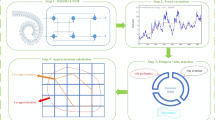Abstract
A method of integrating rough sets and fuzzy multilayer perceptron (MLP) for designing a knowledge-based network for pattern recognition problems is described. Rough set theory is used to extract crude knowledge from the input domain in the form of rules. The syntax of these rules automatically determines the optimal number of hidden nodes while the dependency factors are used in the initial weight encoding. Results on classification of speech data demonstrate the superiority of the system over the fuzzy and conventional versions of the MLP.
Similar content being viewed by others
References
Proc Third Workshop on Rough Sets and Soft Computing (RSSC'94), San José, USA, November 1994.
Proc Fourth International Conference on Soft Computing (IIZUKA96), Iizuka, Fukuoka, Japan, October 1996.
Zadeh LA. Fuzzy logic, neural networks, and soft computing. Comm ACM 1994; 37: 77–84.
Fu LM. Knowledge-based connectionism for revising domain theories. IEEE Trans Systems, Man and Cybern 1993; 23: 173–182.
Towell GG, Shavlik JW. Knowledge-based artificial neural networks. Art Intell 1994; 70: 119–165.
Pawlak Z. Rough Sets, Theoretical Aspects of Reasoning about Data. Kluwer Academic, Dordrecht, 1991.
Skowron A, Rauszer C. The discernibility matrices and functions in information systems. In R. Slowiński, ed. Intelligent Decision Support, Handbook of Applications and Advances of the Rough Sets Theory, Kluwer Academic, Dordrecht, 1992, pp. 331–362.
Slowiński R. ed. Intelligent Decision Support, Handbook of Applications and Advances of the Rough Sets Theory. Kluwer Academic, Dordrecht, 1992.
Yasdi R. Combining rough sets learning and neural learning method to deal with uncertain and imprecise information. Neurocomputing 1995; 7: 61–84.
Czyzewski A, Kaczmarek A. Speech recognition systems based on rough sets and neural networks. Proc Third Workshop on Rough Sets and Soft Computing (RSSC'94), San José, USA, 1994, pp. 97–100.
Szczuka MS. Rough set methods for constructing neural networks, Vol. 7, Engineering Systems Design and Analysis, 1996, pp. 9–14.
Pal SK, Mitra S. Multi-layer perceptron, fuzzy sets and classification. IEEE Trans Neural Networks 1992; 3: 683–697.
Mitra S, Pal SK. Fuzzy multi-layer perceptron, inferencing and rule generation. IEEE Trans Neural Networks 1995; 6: 51–63.
Pal SK, Mandal DP. Linguistic recognition system based on approximate reasoning. Infor Sci 1992; 61: 135–161.
Mitra S. Fuzzy MLP based expert system for medical diagnosis. Fuzzy Sets and Systems 1994; 65: 285–296.
Pal SK, Dutta Majumder D. Fuzzy Mathematical Approach to Pattern Recognition. John Wiley, New York 1986.
Pal SK, Dutta Majumder D. Fuzzy sets and decision making approaches in vowel and speaker recognition. IEEE Trans Systems, Man and Cybern 1977; 7: 625–629.
Author information
Authors and Affiliations
Corresponding author
Rights and permissions
About this article
Cite this article
Mitra, S., Banerjee, M. & Pal, S.K. Rough knowledge-based network, fuzziness and classification. Neural Comput & Applic 7, 17–25 (1998). https://doi.org/10.1007/BF01413706
Issue Date:
DOI: https://doi.org/10.1007/BF01413706




